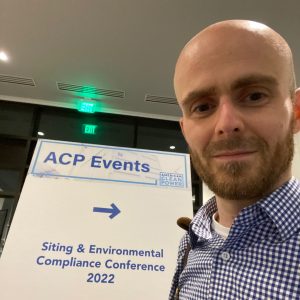I recently attended the annual American Clean Power (ACP) Siting and Environmental Compliance Conference (the “Conference”) that was held on March 29 and 30 in Round Rock, Texas. The Conference covered a broad set of issues related to renewable energy. These included the siting of wind power, power storage, and solar power projects and related topics.
Renewable energy project siting is a multifaceted process that requires consideration of public engagement and opinions. Developers must also assess protected areas and organisms, the impact on infrastructure, and compliance with existing regulations. The conference's breadth means it rarely focuses on any one issue. Instead, it provides an overview of current and emerging issues related to siting and permitting renewable energy.
At the ACP Conference, I had the opportunity to meet with current and potential clients and collaborators. I also gained a better understanding of the state of the industry. Notably, I came away with a clearer picture of important topics on the minds of developers in the field. Here are some key takeaways from the Conference.
Public engagement helps build support for projects
One session this year focused on developing approaches to public engagement. Developers are modifying their approaches to public engagement. Their aim is to better engage with project host communities during and after the siting process. The goal is to define and solidify support for the project while making themselves a part of the community. This can include investing in issues of importance to the community, such as funding the county fair or hiring locally.
While such activities may seem unrelated to acoustics and noise control, there is an extensive body of research indicating that what people think of a sound source and the owner of a sound source can influence how they react to it. In short, how favorably a community views the project developer or owner can influence responses to the project—particularly sound from the project.
Flora and fauna can influence a project's success and impact
Another session discussed landscape planning for solar power projects. The visual impact of solar power projects is a common concern in some surrounding communities. As a result, developers often shield projects using vegetation.
While thin strips of landscaping may provide little benefit to reducing sound levels from a project, there is a possible psychoacoustic benefit of potential noise sources being out of sight, out of mind. Discussions at the Conference covered effective plant arrangements, species mixes, longevity, and the interface between plantings used and facility maintenance.
In addition, a recurring discussion in the context of wind power is how best to curtail turbines to reduce dangers to bats. The current standard to avoid bat fatalities due to wind turbines is curtailment during all conditions that bats could be present, also known as blanket curtailment. However, this results in substantial energy generation loss.
Several speakers presented alternative curtailment methods. These included developing specific criteria for curtailment by monitoring conditions in which bats are present. Other methods called for sensors that can determine when bats are flying in the area to perform curtailments at those times. This results in generation loss reduction and provides more consistent power generation.
Noise control engineering’s role is important but depends on jurisdiction
The focus of my work at RSG, the acoustics and noise control engineering of renewable energy projects, was on display in one poster presentation. This poster discussed the ACP/ANSI standard for sound propagation modeling of wind power projects, particularly using the ISO 9613-2 sound propagation modeling algorithm. Other algorithms such as Harmonoise or Nord2000 are not covered.
The role of acoustics as part of the siting and compliance process varies by jurisdiction. Explicit sound level standards exist in some places. In these cases, developers need preconstruction assessments—and sometimes postconstruction measurements—to assess compliance with these standards. In jurisdictions without standards, a project's acoustics can be assessed as part of reducing its overall impact.

Isaac Old at the American Clean Power Conference in March 2022.
The ACP Conference was an enjoyable opportunity to connect with energy innovators from across the United States and speak with them about some of RSG’s insights in this area. I enjoyed the chance to meet clients and collaborators face-to-face for the first time in two years. The sessions covered a wide range of issues, which ensured there was something of interest for all attendees. Going forward, I am eager to work with our clients to apply the insights and knowledge I gained to RSG’s noise control engineering service work.
······························
Isaac Old is a Senior Consultant at RSG, where he works to develop noise control engineering solutions for clients.



